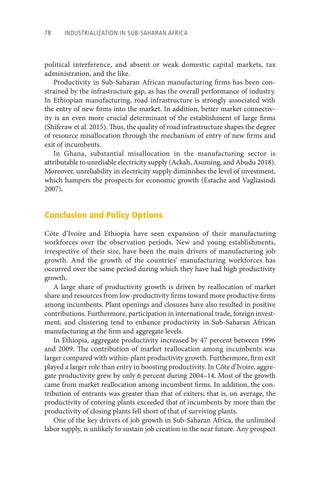78 Industrialization in Sub-Saharan Africa
political interference, and absent or weak domestic capital markets, tax administration, and the like. Productivity in Sub-Saharan African manufacturing firms has been constrained by the infrastructure gap, as has the overall performance of industry. In Ethiopian manufacturing, road infrastructure is strongly associated with the entry of new firms into the market. In addition, better market connectivity is an even more crucial determinant of the establishment of large firms (Shiferaw et al. 2015). Thus, the quality of road infrastructure shapes the degree of resource misallocation through the mechanism of entry of new firms and exit of incumbents. In Ghana, substantial misallocation in the manufacturing sector is attributable to unreliable electricity supply (Ackah, Asuming, and Abudu 2018). Moreover, unreliability in electricity supply diminishes the level of investment, which hampers the prospects for economic growth (Estache and Vagliasindi 2007).
Conclusion and Policy Options Côte d’Ivoire and Ethiopia have seen expansion of their manufacturing workforces over the observation periods. New and young establishments, irrespective of their size, have been the main drivers of manufacturing job growth. And the growth of the countries’ manufacturing workforces has occurred over the same period during which they have had high productivity growth. A large share of productivity growth is driven by reallocation of market share and resources from low-productivity firms toward more productive firms among incumbents. Plant openings and closures have also resulted in positive contributions. Furthermore, participation in international trade, foreign investment, and clustering tend to enhance productivity in Sub-Saharan African manufacturing at the firm and aggregate levels. In Ethiopia, aggregate productivity increased by 47 percent between 1996 and 2009. The contribution of market reallocation among incumbents was larger compared with within-plant productivity growth. Furthermore, firm exit played a larger role than entry in boosting productivity. In Côte d’Ivoire, aggregate productivity grew by only 6 percent during 2004–14. Most of the growth came from market reallocation among incumbent firms. In addition, the contribution of entrants was greater than that of exiters; that is, on average, the productivity of entering plants exceeded that of incumbents by more than the productivity of closing plants fell short of that of surviving plants. One of the key drivers of job growth in Sub-Saharan Africa, the unlimited labor supply, is unlikely to sustain job creation in the near future. Any prospect

